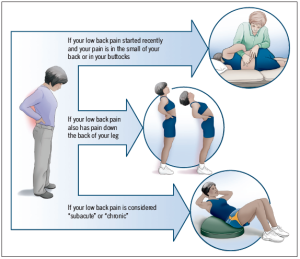
16 Dec How Do We Treat Low Back Pain?
Low back pain is so common that 8 of 10 people experience it at some time in their lives. Although the pain in your back may be severe, most low back pain is not due to a serious problem. Usually back pain is felt in the lower back and buttocks. Sometimes the nerves get irritated and cause leg pain and numbness and tingling in the toes.
There are many risk factors that increase the chances of getting low back pain. The common risks result from lifestyle factors, such as sitting too much, being in poor physical condition, and bending and lifting improperly. Stress and lack of sleep can make the pain worse. As we get older, we often feel more back pain due to weakened muscles and stiffening joints. New clinical practice guidelines for the treatment of low back pain were published in the April 2012 issue of JOSPT. The guidelines describe ways to treat back pain based on best research evidence.
New Insights
Early treatment seems to be key to decreasing your pain and getting back to full activity. Treatments that focus on exercise and staying active limit the amount of time your back pain lasts and reduce the chance that it will reoccur. A physical therapist will tailor treatment to your specific problem, based on a thorough examination and the probable causes of your low back pain.
Practical Advice
For people with low back pain, the good news is that your back will likely feel better, even though the pain may be severe. Staying active is important, and bed rest should be avoided. If you are worried that your pain may not subside, your physical therapist can teach you ways to help you move better and recover faster. Based on your examination, the best treatment for acute low back pain may be manual therapy (mobilization/ manipulation) or exercises that restore motion and decrease pain in the leg that is linked to your low back pain. Exercises that improve coordination, strength, and endurance are best added to treatment once the pain lessens. However, if your pain becomes chronic, moderate- to high-intensity exercises and progressive exercises that focus on fitness and endurance are helpful in pain management. Your physical therapist can help customize an exercise program for you. For more information on the treatment of low back pain, contact your physical therapist specializing in musculoskeletal disorders.
Low Back Pain Treatments
Evidence suggests that early treatment for low back pain is helpful in decreasing the chance that your pain will become chronic. Not all low back pain should be treated the same. Your physical therapist can help determine if you will respond better to manipulation (top of illustration above) or exercises to improve mobility and/or strengthen your back muscles. After a thorough evaluation, your physical therapist can help determine which treatment is best for you.
For this and more topics, visit JOSPT Perspectives for Patients online at www.jospt.org.
This JOSPT Perspectives for Patients is based on an article by Delitto A et al, titled “Clinical Practice Guidelines Linked to the International Classification of Functioning, Disability, and Health From the Orthopaedic Section of the American Physical Therapy Association (J Orthop Sports Phys Ther 2012;42(4):A1-A57. doi:10.2519/jospt.2012.0301).
This Perspectives article was written by a team of JOSPT’s editorial board and staff, with Deydre S. Teyhen, PT, PhD, Editor, and Jeanne Robertson, Illustrator.






